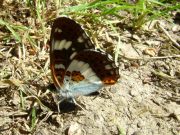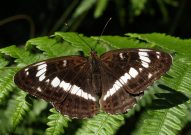 |
 |
| © photo: Graham Elcombe | © photo: Lee Browne |
Eggs are laid singly on honeysuckle (lonicera periclymenum) leaves and hatch after 7-14 days. The eggs are a greenish colour and have a honeycombed and hairy shell.
The caterpillar feeds into October. It rests along the midrib of a honeysuckle leaf and eats the leaf from the tip backwards towards the stem. To begin with the caterpillar rests on a silk pad and under a silk sheaf adorned with droppings, after a couple of weeks it rests in the open on the leaf. The winter is passed in an hibernaculum which is made by attaching a leaf to the honeysuckle stem with silk and then folding the leaf over itself. In the spring the caterpillar feeds on the emerging rosettes of leaves. Up until its final moult it is spiny brown caterpillar, after its final moult it turns green.
The pupa is formed during June and hangs down from a leaf or the honeysuckle stem. It is green and brown and attached with an orange silk pad.
Flight time is within the period from the 3rd week of June to the 3rd week of August at the extremes, but is typically 4th week of June to 1st week of August, with the middle of July being the best time to see the adult. (In 2009 there was a single report of a second generation White Admiral on 3rd October at Ruislip Woods.) Their flight is very distinctive as they are large (Red admiral size) and are one of the few British butterflies to glide. No other butterfly is this dark chocolate brown on the upper wing and the paler brown and white on the underwing. Only the Purple Emperor is in any way similar and this is larger and much less likely to be seen low down or feeding on nectar, although it may appear brown in certain lights, it is also more angular. Whereas the White Admiral is a distinctly rounded butterfly.
Table 1: Flight dates 2005 - 2010 |
|
| Flight Dates | Year |
| 22 June - 9 August | 2010 |
| 07 June - 02 August | 2009 |
| 15 June - 30 July | 2008 |
| 09 June - 01 August | 2007 |
| 18 June - 30 July | 2006 |
| 19 June - 15 August | 2005 |
The White Admiral can be seen anywhere from ground level to tree top level and will rapidly glide from low to high and down again. It is fond of nectar, particularly bramble and I have also seen it on hogweed.. They have very specific habitat preferences - shady woodland where honeysuckle grows.
For breeding straggling, shaded honeysuckle is most likely to be used. Fresh cut coppice is not a favourable habitat. However they can wander and have been seen well away from such habitats such as in Hemel Hempstead and Ware.
Large woodlands, with honeysuckle growing in reasonable but not heavy shade.
Known and possible sites are listed on the link below. Our aim should be to visit as many as possible looking for signs of the butterfly or its food plant and recording whether the site is a likely one. Where the butterfly is found we need to establish the owner and what management is in place at the site to ensure the continued presence of this butterfly.
Possible and known sites for the White Admiral in Hertforshire & Middlesex
Text by Andrew Wood
March 2002 updated April 2010
Please send any records or information regarding potential sites to:
Andrew Wood
Telephone: 01992 503571
Email: zoothorn@ntlworld.com